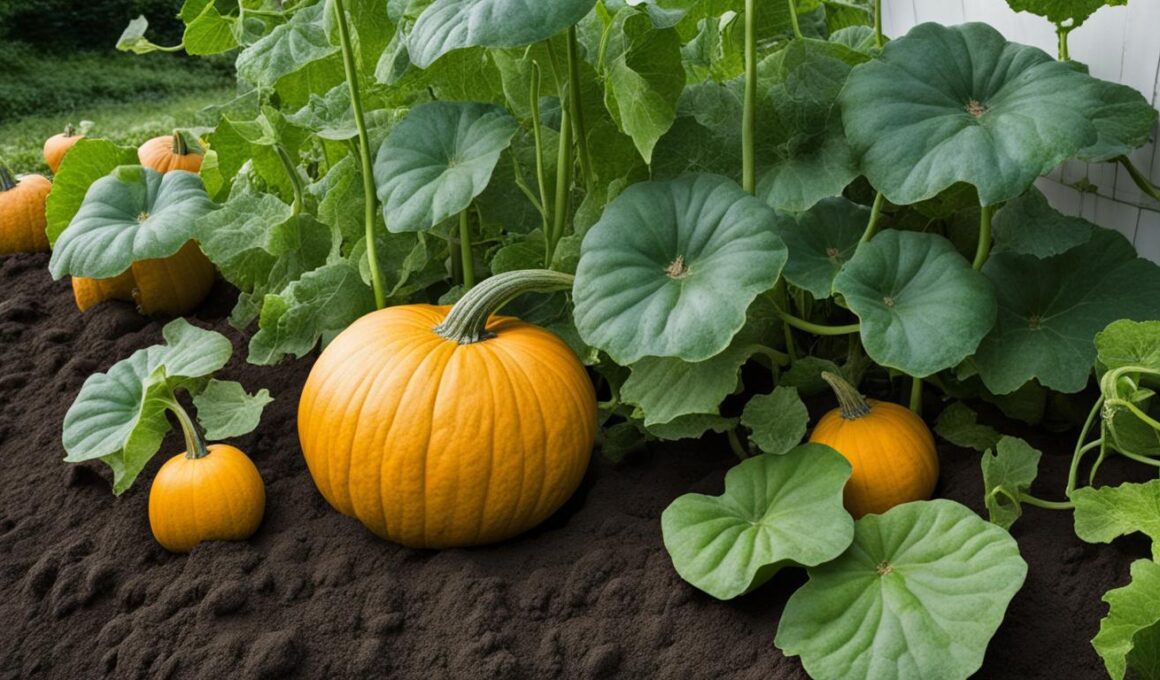Pumpkins require a consistent water supply for optimal growth. The general rule of thumb is to provide around 1 inch of water per week. However, the specific water requirements can vary depending on soil type, climate, and pumpkin variety.
Sandy soils drain quickly and may require more frequent watering, while clay soils retain moisture for longer periods. In hot, dry weather, pumpkins may need more water to prevent wilting. It’s important to check the soil moisture regularly and water deeply to encourage deep root growth.
Tips for Watering Pumpkins
To ensure proper hydration for your pumpkin plants, you need to consider various factors, such as soil type, climate, and the specific pumpkin variety. These factors play a crucial role in determining the optimal hydration for your pumpkins.
If you have sandy soil, it tends to drain quickly, requiring more frequent watering to maintain proper moisture levels. On the other hand, if your soil is more clay-like, it retains moisture for longer periods, resulting in less frequent watering.
Climate also plays a significant role in determining pumpkin hydration. In hot and dry weather conditions, your pumpkins may need more water to prevent wilting and maintain optimal growth. Keeping a close eye on the soil moisture and weather conditions will help you determine when to water your pumpkins.
When it comes to watering techniques, it’s recommended to water deeply and infrequently rather than giving small amounts of water frequently. Deep watering encourages deep root growth, allowing the plant to withstand drought conditions and improving its overall hydration.
Remember, the specific pumpkin variety you are growing may have unique water requirements. Therefore, it’s important to research and understand the specific needs of your chosen variety to ensure its proper hydration.
To visually understand the importance of proper hydration for pumpkins, take a look at this image:
By following these tips and considering the various factors that influence pumpkin hydration, you can ensure the proper growth and development of your pumpkin plants.
The Science Behind Watering Pumpkins
Pumpkins have relatively high water requirements compared to other crops. Their large leaves transpire significant amounts of water into the atmosphere, necessitating the intake of considerable water by the roots. Inadequate water can lead to impaired nutrient uptake, slower growth, and diminished fruit production.
The water requirements of pumpkins vary depending on factors such as growth stage, soil type, and weather conditions. During the early stages, consistent moisture is necessary for establishing root systems. As the plants mature, they require less frequent watering but still need consistent moisture for fruit development. Soil type, weather conditions, and deep root growth are crucial considerations when watering pumpkins.
- Transpiration: Pumpkins have large leaves that transpire significant amounts of water into the atmosphere. This process is essential for cooling the plant and exchanging gases but also increases their water requirements.
- Nutrient Uptake: Inadequate water can impair the plant’s ability to uptake nutrients from the soil. This can lead to nutrient deficiencies and hinder the pumpkin’s growth and development.
- Growth and Development: Water plays a critical role in the growth and development of pumpkins. Consistent moisture is necessary for establishing roots, and adequate water supply is required for fruit development.
Understanding the science behind watering pumpkins helps ensure optimal growth and abundant harvest. By meeting their water requirements, you can provide the necessary conditions for healthy root systems, nutrient uptake, and overall plant development.
Conclusion
To maximize the yield of your pumpkins, it’s essential to employ effective watering techniques. Implementing these techniques will help ensure optimal growth and a bountiful harvest.
One key practice is to time your waterings in the morning. This allows the plants to absorb the moisture and utilize it throughout the day for growth and development. Utilizing soaker hoses or drip irrigation systems can also be beneficial, as they deliver water directly to the root zone, minimizing waste through evaporation or runoff.
Another important technique is mulching around the pumpkin plants. This helps to retain moisture in the soil, reducing the need for frequent watering. Additionally, monitoring soil moisture levels is crucial. By regularly checking the moisture content, you can ensure that the plants are receiving the right amount of water without over or under-watering them
Understanding the science behind watering and its impact on growth and development can greatly contribute to maximizing yields. By following proper watering techniques, you can optimize the water cycle in your pumpkin garden, allowing the plants to thrive and produce abundant, healthy fruits. So, be mindful of your watering practices, and watch as your pumpkin harvest flourishes.
Can the Watering Needs for Santa Rosa Plums be Applied to Pumpkins as Well?
When it comes to watering, pumpkins and weeping Santa Rosa plum care have different needs. While Santa Rosa plums need regular watering, pumpkins thrive with less water. It’s important to adjust your watering strategy and provide adequate moisture for each plant based on their individual requirements.










